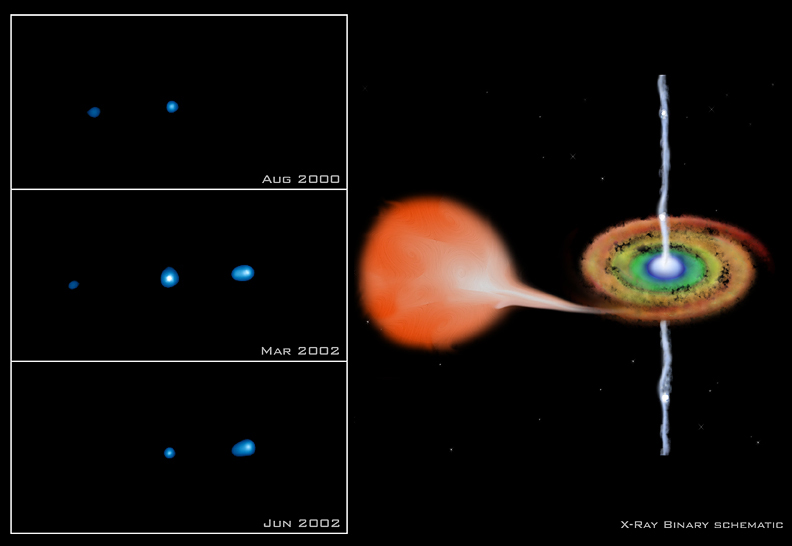
 Credit: Left: X-ray (NASA/CXC); Right: Illustration (CXC/M.Weiss)
Credit: Left: X-ray (NASA/CXC); Right: Illustration (CXC/M.Weiss)
Escape from the Black Hole
Black holes not only swallow matter, they can also eject matter. If a black hole
is surrounded by a ring of swirling material (called an accretion disk), some of
the material gets swallowed while some may get propelled in fast moving jets off
the disk. These jets seem to be a characteristic of accreting black holes,
though how the jets are formed is not precisely known. Mega-massive black holes
at the centers of galaxies show such jets, which often stretch for millions of
light years. On smaller scales, stellar-sized black holes show the same type of
jet phenomena, due (astronomers believe) to the same physical mechanism as in
their much larger cousins. These smaller black holes provide a laboratory for
jet physics, since they evolve rapidly so that astronomers can study in detail
how the jets are formed and how they fade away. The image above is a set of Chandra X-ray Observatory images of X-ray emission
from XTEJ1550-564, a binary star composed of a "normal" star with a black
hole companion. In 1998 the star underwent an X-ray explosion detected by the RXTE satellite, and
this explosion apparently produced (or at least lit up) jets of material
speeding away from the star at about half the speed of light. The Chandra image
at the top left shows X-rays from the black hole at the center of the image and
an X-ray bright spot marking the tip of the jet to the left of the star. In the
image below that, the counter jet to the right of the star has appeared bright
in X-rays, while the jet on the left shows clear motion away from the star.
Finally the last image at the lower left shows that the X-ray emission from the
left jet faded, while the jet on the right remained bright. The image on the
right is an artist's representation of XTEJ1550-564 showing the normal star
feeding the accretion disk around the black hole.
Last Week *
HEA Dictionary * Archive
* Search HEAPOW
* Education
Each week the HEASARC
brings you new, exciting and beautiful images from X-ray and Gamma ray
astronomy. Check back each week and be sure to check out the HEAPOW archive!
Page Author: Dr. Michael F. Corcoran
Last modified €


